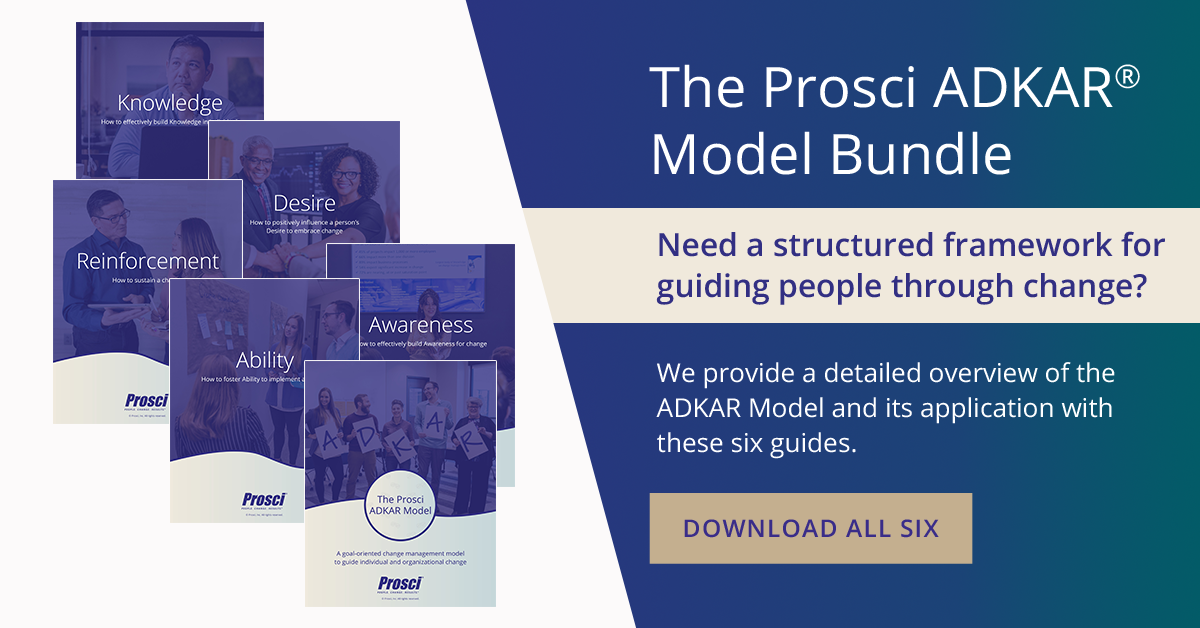The ADKAR Model: 5 Obstacles to Building Awareness For Change

2 Mins
Updated: August 12, 2022
Published: May 10, 2016

I was one of those dogged (or, as I like to think, “passionate”) children who did not change easily once my mind was set. My poor parents had to be prepared with a litigation-worthy defense to dissuade me. “Because I said so” did not fly; I simply had to understand why they wanted me to do something differently in order to consider it.
But it’s not just headstrong children who have to know why they are being asked to change their ways. People in general need to have an awareness of the need for a change before they can buy in.
This is why the Prosci ADKAR Model starts with awareness of the need for change. Communicating a change is happening without providing the why is the adult equivalent of saying “because I said so.” People need to know the real why. However, even when we clearly communicate why a change is needed, we can run into obstacles to building awareness. Let’s look at some of the most common obstacles and what you can do about them.
A Person’s View of the Current State
 People who are very comfortable or invested in the current state may deflect awareness messages simply because they represent a change to the status quo. They may even argue against the reasons for a change in favor of keeping the more comfortable current state. A more personal, one-on-one approach can help here. Taking time to understand the person’s attachment to the current state can aid in creating a tailored “why” message that demonstrates why the change will ultimately benefit the person more than staying put.
People who are very comfortable or invested in the current state may deflect awareness messages simply because they represent a change to the status quo. They may even argue against the reasons for a change in favor of keeping the more comfortable current state. A more personal, one-on-one approach can help here. Taking time to understand the person’s attachment to the current state can aid in creating a tailored “why” message that demonstrates why the change will ultimately benefit the person more than staying put.
How a Person Perceives Problems
Some individuals will have already spotted the need for change or, if they haven’t, will quickly get their mind around why a change is needed. Others may be completely caught off-guard and need time to adjust. Understanding people’s processing speed is essential. Provide the time and opportunities to circle back in order to help people process awareness messages according to their personal style.
The Credibility of the Sender
 Who sends the awareness messages impacts whether they are received and thought to be credible. Research shows that messages around why the change is being made and how it aligns with the business strategy are most credible from senior leaders. Messages about how the change will impact employees personally and the “what’s in it for me” are most credible from their manager. Also, if leaders have made unfulfilled promises in the past or otherwise destroyed trust with employees, their level may not matter. They are no longer a trusted source of information. In this case, alternative senders of the message may be needed to communicate to an employee.
Who sends the awareness messages impacts whether they are received and thought to be credible. Research shows that messages around why the change is being made and how it aligns with the business strategy are most credible from senior leaders. Messages about how the change will impact employees personally and the “what’s in it for me” are most credible from their manager. Also, if leaders have made unfulfilled promises in the past or otherwise destroyed trust with employees, their level may not matter. They are no longer a trusted source of information. In this case, alternative senders of the message may be needed to communicate to an employee.
Circulation of Misinformation or Rumors
In the absence of official information, people will fill the gaps in with rumors. Don’t underestimate employees’ ability to sense when something is happening—or to creatively fill in the blanks. If rumors have started to spin, leaders and managers need to spend extra time correcting misinformation. Share what you do know, and what you do not know. Take time to listen to what people have heard and dispel what is not true. Give employees time to decipher the real information from the fabricated and get on board.
The best strategy for this obstacle is to not let it happen. Communicate the right information from the start. Even if all information is not yet solidified, it is better to start communicating clearly what is known and what is not yet known.
Contestability of the Reasons for Change
While some changes have external and observable reasons that are difficult to dispute (like new industry regulations that require compliance) other changes have reasons that are internally oriented and not obvious to employees. If the reasons for change are not driven by external factors and therefore open to debate, extra time will be needed to build awareness.
What This Means for You
As you consider the changes you are leading, evaluate your strategy for building awareness. Consider these obstacles; are you running into any of them? Do you see potential for them to emerge? Be mindful that communicating the “why” isn’t always enough and be prepared to implement special tactics should you run into any of these issues.


